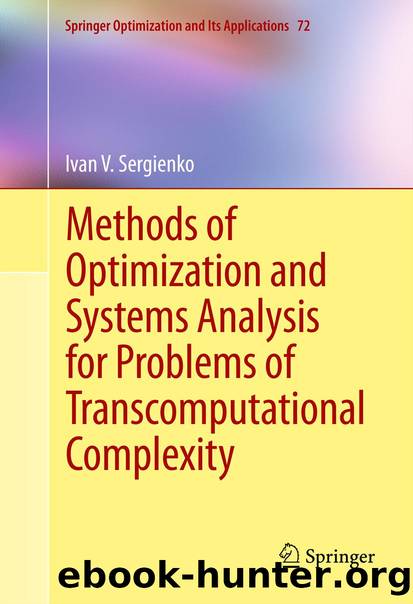Methods of Optimization and Systems Analysis for Problems of Transcomputational Complexity by Ivan V. Sergienko

Author:Ivan V. Sergienko
Language: eng
Format: epub
Publisher: Springer New York, New York, NY
One of the modifications of the method can be described as follows. Construct a sequence , where is a step factor and is a vector defined as a solution of the quadratic programming problem
The factor , where is the first value of the index that satisfies the inequality
N is a sufficiently large constant and .
The implementation of the linearization method implies that the problem solution exists for any x. The function plays a special role, both ideologically and numerically. It turns out that for many nonlinear programming problems, is an exact penalty function for sufficiently large N. The problem solution at nonstationary points determines the descent direction of the function . The range of nonlinear programming problems for which the conditions whereby is an exact penalty function are satisfied is rather wide, which provides ample opportunities for applying the linearization method.
Supporting optimization research, Mikhalevich did not forget about more complex problems such as control problems where optimization methods play a key role. Large groups of experts in automatic control theory (A. G. Ivakhnenko, A. I. Kukhtenko, V. М. Kuntsevich, Yu. I. Samoilenko, V. I. Ivanenko) and in optimal control theory (B. N. Pshenichnyi, A. A. Chikrii) worked at the Institute of Cybernetics.
The investigations by the above authors, in particular Kuntsevich, were concerned with the development and dynamic analysis of sampled-data extremum self-adjusting automatic control systems [83]. The wide use of impulsive (discrete-time) elements and means of automation and computing technique stimulated the development of methods for the mathematical description and analysis of nonlinear sampled-data systems with frequency and frequency-width modulation [87]. Kuntsevich and his disciples paid much attention to the analysis of nonlinear difference equations that describe the dynamics of such systems, to the analysis of periodic processes, and to the application of the Lyapunov function method to derive the asymptotic stability and dissipativity conditions. Frequency methods were also developed for the analysis of nonlinear nonstationary control systems, both deterministic and stochastic.
The synthesis of feedback control for deterministic continuous- and discrete-time, generally nonlinear and nonstationary systems, was put in the forefront. However, as is often the case in solving scientific problems, analysis and synthesis problems appeared to be closely related to each other. Synthesis problems were solved based on a unified methodological basis, with the use of Lyapunov functions and their discrete analogues [86]. Synthesis problems for asymptotically stable control systems were solved for a rather wide class of linear and nonlinear control objects under various constraints imposed on the control. The solution of a strengthened problem was considered, where the synthesized control should not only provide the asymptotic stability (or dissipativity) of the system but also minimize some loss function. The solution of the generalized synthesis problem was obtained, according to which the synthesized control should minimize a performance functional. General theorems on the properties of optimal control were proved with the use of Lyapunov functions [85, 86]. For a nonlinear object and general form of the performance functional, a theorem on the optimality “in the small” was proved,
Download
This site does not store any files on its server. We only index and link to content provided by other sites. Please contact the content providers to delete copyright contents if any and email us, we'll remove relevant links or contents immediately.
Algorithms of the Intelligent Web by Haralambos Marmanis;Dmitry Babenko(16237)
Jquery UI in Action : Master the concepts Of Jquery UI: A Step By Step Approach by ANMOL GOYAL(9389)
Test-Driven Development with Java by Alan Mellor(7737)
Data Augmentation with Python by Duc Haba(7610)
Principles of Data Fabric by Sonia Mezzetta(7380)
Learn Blender Simulations the Right Way by Stephen Pearson(7296)
Microservices with Spring Boot 3 and Spring Cloud by Magnus Larsson(7139)
Hadoop in Practice by Alex Holmes(6589)
RPA Solution Architect's Handbook by Sachin Sahgal(6519)
The Infinite Retina by Robert Scoble Irena Cronin(6218)
Big Data Analysis with Python by Ivan Marin(5937)
Life 3.0: Being Human in the Age of Artificial Intelligence by Tegmark Max(5520)
Pretrain Vision and Large Language Models in Python by Emily Webber(4897)
Infrastructure as Code for Beginners by Russ McKendrick(4654)
Functional Programming in JavaScript by Mantyla Dan(4438)
WordPress Plugin Development Cookbook by Yannick Lefebvre(4386)
The Age of Surveillance Capitalism by Shoshana Zuboff(4252)
Embracing Microservices Design by Ovais Mehboob Ahmed Khan Nabil Siddiqui and Timothy Oleson(4149)
Applied Machine Learning for Healthcare and Life Sciences Using AWS by Ujjwal Ratan(4136)
